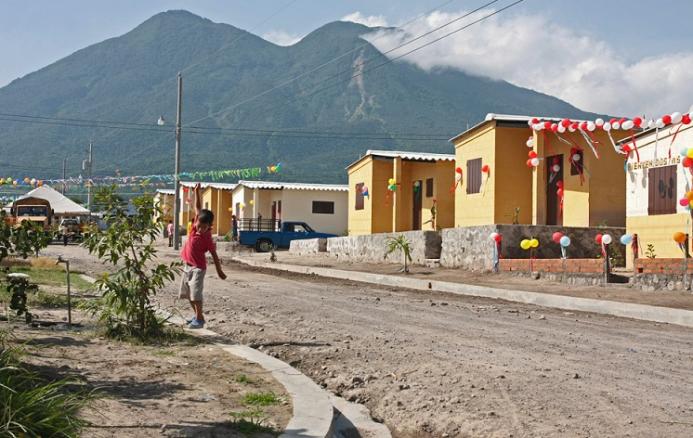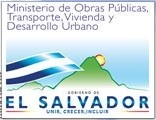El Salvador's Second National Communication
Project Overview
The creation of a National Communication offers countries the opportunity to contribute with technically sound studies and information that can be used for designing mitigation and adaptation measures, and project proposals that can and will help increase their resilience to the impacts of climate change. Activities generally include: V&A assessments, Greenhouse Gas Inventory preparation, Mitigation Analysis or Education, and awareness raising activities. The ultimate goal is the integration of climate change considerations into relevant social, economic and environmental policies and actions.
Agriculture, water, coasts and forests have been identified as priority areas for adaptation in El Salvador. These areas have been identified through a series of key national documents including the country's First National Communication. Following the relase of El Salvador's First National Communication, assessments and adaptation strategies have been under development focusing on coasts, agriculture (particularly staple foods and coffee) and forests. More recently, El Salvador’s “Five-Year Development Plan” highlights agriculture, water management and ecosystems in the context of climate change adaptation. The Plan ultimately calls for the development of a national climate change policy, which is now forthcoming.
To view progress on El Salvador's SNC click here.
Project Details
Lying along the Pacific Ocean and bordered by Guatemala and Honduras, the relatively small country of El Salvador is home to about six million people. El Salvador has an area of 20,740 km2, with important geographical and ecological variations. Approximately 86% of the national territory is ranked as subtropical humid forests, 8% as sub-tropical very humid forests and 4% as tropical humid forest land10. Annual average rainfall fluctuates between 1,525.8 mm and 2,127.2 mm, with an average of 1,823.6 mm. Annual average temperatures range between 24.2oC and 25.9oC, with an average of 24.8oC.
Geographically, the country is divided into three distinct regions: the southern coastal belt, the central valley and plateaus, and the northern mountains. Since its civil war ended in 1992, El Salvador’s economy has grown steadily, with per capita income reaching approximately US$7,300 in 2010 (CIA, 2011). The poverty rate has declined from 66 per cent in 1991 to 37.8 per cent in 2009 (USDS, 2011). While agriculture remains a significant portion of El Salvador’s economy (generating 11 per cent of Gross Domestic Product (GDP) in 2010), manufacturing (particularly textiles and apparel) and the services sector now generate 23 per cent and 58 per cent of GDP respectively (CIA, 2011). Remittances are also an important source of income (USDS, 2011).
El Salvador, through its government and particularly through the MARN, which is the entity accountable for coordinating the preparation and follow up of an environmental policy, would be committed to establish the mitigation and adaptation to climatic change strategies provided that these help to achieve national priorities and that they foster sustainable domestic development.
The Ministry of Environment and Natural Resources is currently working on a National Climate Change Plan that will include: i) the National Action Program on Adaptation (NAPA); ii) the National Appropriate Mitigation Actions (NAMAs) in the context of the national development priorities; iii) science and technology for adaptation and mitigation; iv) national and local capacity building for adaptation and mitigation; and v) education, public awareness raising and participation of the relevant actors and sectors in the design and implementation of the national public policies related to climate change.
The Project on Capacity building for Stage II adaptation to climate change (Costa Rica, Cuba, El Salvador, Guatemala, Honduras, Mexico, Nicaragua, Panama) was funded through the GEF Trust Fund and is implemented by UNDP. Central America, Mexico and Cuba serve as the pilot region for elaborating and applying an Adaptation Policy Framework for preparing adaptation strategies, policies and measures. The application of this framework demonstrated how policy for adaptation can be integrated into national sustainable development for at least three human systems: water resources, agriculture and human health. This demonstration project builds upon the Stage I vulnerability and adaptation assessments of the Initial National Communications of the eight participating countries of the region and will prepare them to move onto Stage III Adaptation. The outputs of the project, Stage II adaptation strategies are being used for preparing Second National Communications and to take steps to submit adaptation initiatives to the Special Climate Change Fund and to other financing mechanisms.
Adaptation Needs and Priorities
El Salvador has a relatively homogeneous climate. Nevertheless, climate hazards exist, and include droughts (which are noted to be increasing in length), floods and hurricanes (MARN, 2000). National temperatures have been increasing by approximately 0.35°C per decade; climate models project that temperatures will increase by 2.5° to 3.7°C by 2100. Projections are much less certain with regards to rainfall; the country has experienced a statistically insignificant reduction in rainfall in the past few decades, and projections range from declines of 36.6 per cent to increases of 11.1 per cent by the end of the century, according to the Ministry for Environment and Natural Resources (MARN) (MARN, 2000). Finally, the country’s coastal zones are expected to be affected by rising sea levels.
Agriculture, water, coasts and forests have been identified as priority areas for adaptation in El Salvador. These areas have been identified through a series of key national documents. In the country’s first (and so far only) National Communication to the United Nations Framework Convention on Climate Change (UNFCCC), released in 2000, the vulnerability of the country’s coasts and agricultural sector were assessed (MARN, 2000). Guidelines for a national adaptation strategy were developed following the release of the First National Communication, and focused on coasts, agriculture (particularly staple foods and coffee) and forests. More recently, El Salvador’s “Five-Year Development Plan” highlights agriculture, water management and ecosystems in the context of climate change adaptation (El Salvador, 2010). The Plan calls for the development of a national climate change policy, which is now forthcoming.
Beyond government documentation, a 2007 report from the United Nations Development Programme (UNDP) and the Global Environment Facility (GEF) studied the vulnerability and adaptation needs of the rural population in the central coastal plains. More specific research on drought has included an analysis of national drought policies (Romano, 2003) and a “Policy and Action Plan on Living with Droughts in El Salvador” (FUNDE, 2003); both highlight the importance of droughts for El Salvador, particularly its agriculture sector. Priority areas for adaptation action are currently being reviewed as the government develops its national climate change policy and finalizes its Second National Communication.
No list of prioritized adaptation action exists in El Salvador. Nevertheless, some key actions have been identified, particularly for the agricultural sector, including: the generation and cultivation of new crop varieties; improved water supply and irrigation; soil plant coverage; early warning systems; harvest forecasts; food surveillance systems; farming investment; insurance schemes; research and development; economic policy measures to stimulate grain production; more sustainable agricultural practices; farm zoning programs; and institutions that promote human development and food security (MARN, 2000). No measures are suggested for coastal areas. UNDP and GEF (2007) also identify a set of adaptation measures related to rural livelihoods, with a focus on agriculture.
National Level Policies and Strategic Documents
El Salvador is a signatory to the UNFCCC, with the Ministry for Environment and Natural Resources serving as the focal point for the process. The Ministry produced its First National Communication in 2000, and planned to publish its second in 2010, though it has yet to be released.
Climate change and adaptation are referred to in the “Environment and Risk Reduction Policy” section of El Salvador’s recent Five-Year Development Plan (El Salvador, 2010). The plan highlights the links between adaptation and ecosystems, water management and agriculture, and calls for the development of a national climate change policy to mainstream climate change into sectoral policies on health, agriculture, energy, transport, infrastructure, water management and waste.
El Salvador is a member of the Central American Integration System (SICA), the institutional framework for the integration of Central American states, and of the Central American Commission for Environment and Development (CCAD), a committee which brings together the environmental ministries of the SICA member states. Under the auspices of SICA and CCAD, a regional climate change strategy has recently been developed (CCAD and SICA, 2010). The strategy summarizes climate information and sectoral vulnerabilities, and proposes six strategic areas for action, including “Vulnerability and adaptation to climate variability and change, and risk management.” Under this theme, nine strategic objectives (with over 150 measures) are listed: disaster risk reduction, agriculture and food security, forest ecosystems and biodiversity, water, health, coastal-marine systems, tourism, indigenous people and public infrastructure. The strategy’s other focal areas are: mitigation; capacity building; education, awareness raising, communication and participation; technology transfer; and international negotiations and management.
Current Adaptation Action
El Salvador has a moderate amount of adaptation action currently underway, which mostly focuses on regional capacity building and research programs on climate change adaptation. Agriculture, water and coastal areas, identified as key areas for adaptation, are reflected in current adaptation activities. However, many adaptation needs remain unaddressed, such as in the areas of human health, gender and ecosystem conservation. One project focused on providing safe drinking water in the region of Zacatecoluca involves the implementation of adaptation concrete measures. Outside of this project, the majority of adaptation activity in El Salvador involves capacity building, research and policy formation and integration.
Proposed Adaptation Action
Plans are in place to expand adaptation programming in El Salvador. Action has been proposed in the areas of sustainable natural resources management, food security and coastal zone management, to be funded by the United States Agency for International Development (USAID), as well as significant planned investments in strengthening infrastructure resilience in San Salvador. The Inter-American Development Bank (IADB) is also preparing a program to support structural reform in the area of climate change and energy, although further details on the program have not yet been released.
Assessment
Overall, El Salvador has made progress in the area of adaptation, particularly in terms of research, capacities and political awareness. Agriculture, water, coasts and, to a lesser extent, forests and ecosystems are acknowledged as the key sectors for adaptation in El Salvador, and climate change is recognized as an important issue in the country’s development. At the policy level, it is expected that the soon-to-be-released Second National Communication and national climate change policy will further specify areas and actions that should be prioritized for adaptation. At the implementation level, current adaptation activities largely take place as part of regional or global projects and focus on capacity building and research. These projects are addressing needs in the priority sectors of agriculture, water and coasts. Among identified future adaptation actions, the focus is on food security, biodiversity and policy reform.
References:
- Keller, Echeverría, Parry (2011) “Review of Current and Planned Adaptation Action: Central America and Mexico.” Adaptation Partnership / International Institute for Sustainable Development.
- Central Intelligence Agency [CIA] (2011). El Salvador. The World Factbook. Retrieved from https://www.cia.gov/library/publications/the-world-factbook/geos/es.html. Last updated 25 April 2011.
- Comisión Centroamericana de Ambiente y Desarrollo [CCAD] and Sistema de la Integración Centroamericana [SICA] (2010). Estrategia Regional de Cambio Climático. Documento Ejecutivo.
- El Salvador (2010). Plan Quinqueñal de Desarrollo 2010–2014.
- Fundación Nacional para el Desarrollo [FUNDE] (2003). Política y Plan de Acción de Convivencia con la Sequía en El Salvador.
- Gavidia Medina (2001). Líneas Prioritarias de Acción para la Definición y Ejecución de una Estrategia de Adaptación al Cambio Climático en El Salvador.
- Ministerio de Medio Ambiente y los Recursos Naturales [MARN] (2000). First National Communication of the Republic of El Salvador. Retrieved from http://unfccc.int/essential_background/library/items/3599.php?such=j&symbol=SLV/COM/1%20B#beg
- Romano, L. (2003). Evaluación de las Políticas para Enfrentar la Sequía en El Salvador dentro del Marco del Desarrollo y la Transferencia de Tecnologías de Adaptación ante la Variabilidad y el Cambio Global del Clima.
- United Nations Development Programme [UNDP] and Global Environment Facility [GEF] (2007). Vulnerabilidad y adaptación al cambio climático de los pobladores rurales de la planicie costera central de El Salvador.
- United States Department for State [USDS] (2011). Background Note: El Salvador. Last updated 30 March 2011. Retrieved fromhttp://www.state.gov/r/pa/ei/bgn/2033.htm.
Key Results and Outputs
- Sustainable development and the integration of climate change concerns into medium- and long-term planning
- Inventories of anthropogenic emissions by sources and removals by sinks of greenhouse gases
- Measures contributing to addressing climate change
- Research and systematic observation
- Climate change impacts, adaptation measures and response strategies
- Education, training and public awareness
Potential Adaptation Measures
Agriculture and Food Security
- Educational & outreach activities to change management practices to those suited to climate change
- Switch to different cultivars
- Improve and conserve soils
- Develop new crops
- Develop and introduce policy measures, including taxes, subsidies, facilitation of free market
- Develop early warning systems and disaster preparedness
Water Resources
- Increase water supply, e.g. by using groundwater, building reservoirs, improving or stabilizing watershed management, desalination
- Decrease water demands, e.g. by increasing efficiency, reducing water losses, water recycling, changing irrigation practices
- Improve or develop water management
Monitoring and Evaluation
In 1992, countries joined an international treaty, the United Nations Framework Convention on Climate Change, to cooperatively consider what they could do to limit average global temperature increases and the resulting climate change, and to cope with whatever impacts were, by then, inevitable.
Parties to the Convention must submit national reports on implementation of the Convention to the Conference of the Parties (COP). The required contents of national communications and the timetable for their submission are different for Annex I and non-Annex I Parties. This is in accordance with the principle of "common but differentiated responsibilities" enshrined in the Convention.
The core elements of the national communications for both Annex I and non-Annex I Parties are information on emissions and removals of greenhouse gases (GHGs) and details of the activities a Party has undertaken to implement the Convention. National communications usually contain information on national circumstances, vulnerability assessment, financial resources and transfer of technology, and education, training and public awareness.
Since 1994, governments have invested significant time and resources in the preparation, collection and validation of data on GHG emissions, and the COP has made determined efforts to improve the quality and consistency of the data, which are ensured by established guidelines for reporting. Non-Annex I Parties receive financial and technical assistance in preparing their national communications, facilitated by the UNFCCC secretariat.




